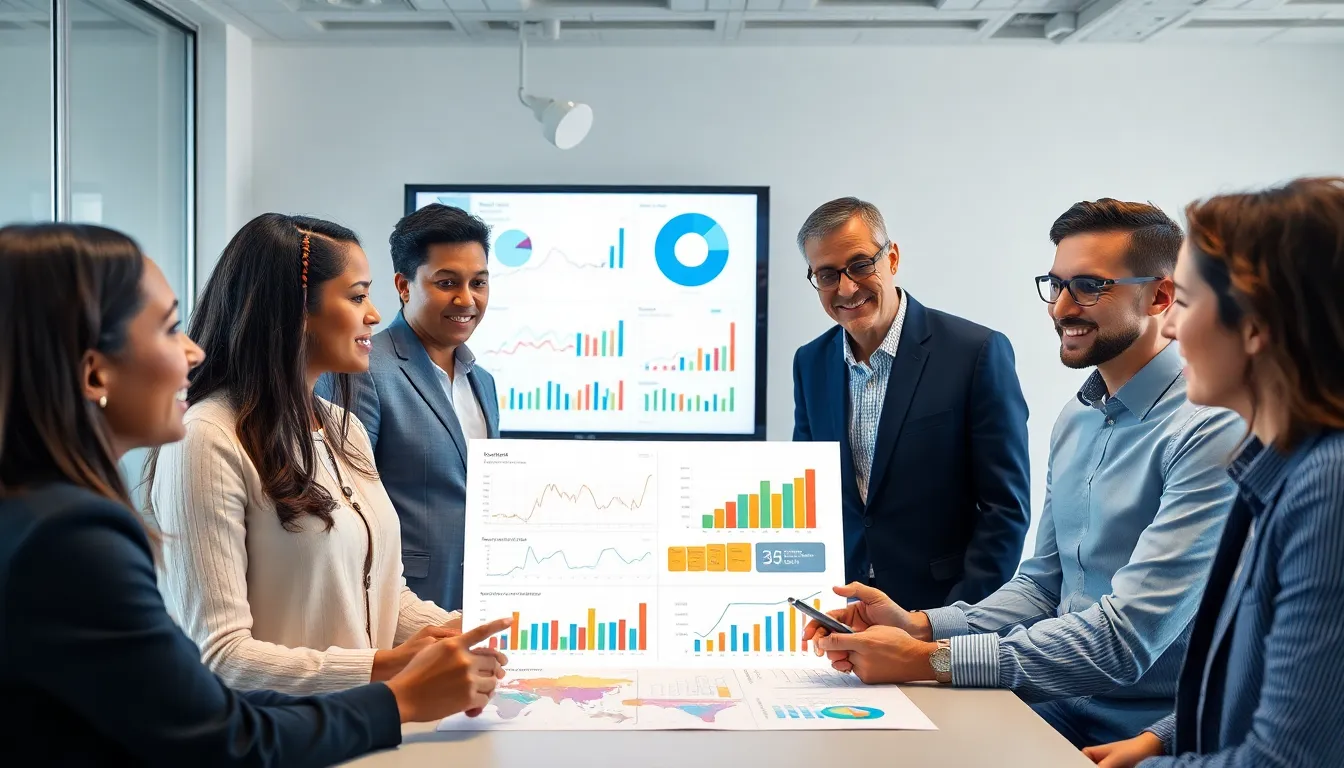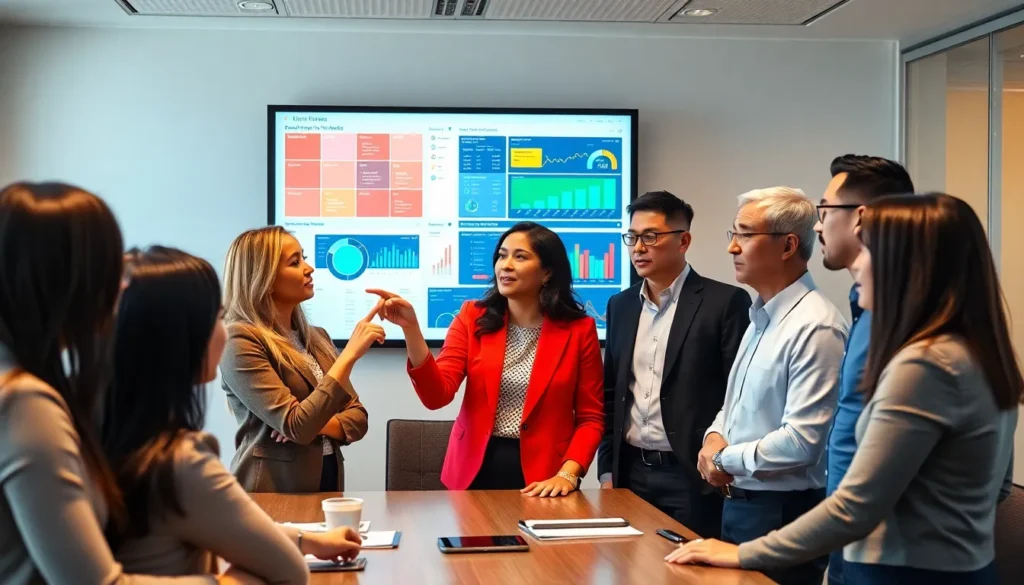In an age where information overload is the norm, data visualization stands out as a powerful tool for clarity. It transforms complex data sets into engaging visuals, making it easier for individuals and organizations to grasp insights quickly. Whether through charts, graphs, or infographics, effective data visualization can turn raw numbers into compelling stories that drive decision-making.
As businesses increasingly rely on data to guide their strategies, mastering the art of visualization becomes crucial. It not only enhances comprehension but also fosters better communication among teams. By leveraging the right visual techniques, anyone can unlock the potential of their data and present it in a way that resonates with their audience.
Table of Contents
ToggleOverview of Data Visualization
Data visualization simplifies complex data into clear, engaging visuals. It combines elements like charts, graphs, and infographics to enhance understanding. Utilizing effective visualization techniques, organizations facilitate quicker insights.
Data visualization plays a critical role in decision-making. Businesses leverage these visuals to identify trends, patterns, and anomalies quickly. A well-designed chart communicates insights faster than raw data, improving strategic analysis and execution.
Key benefits of data visualization include:
- Enhanced Clarity: Clear visuals convey information simply.
- Increased Engagement: Engaging graphics capture audience attention.
- Efficient Communication: Quick insights lead to informed decisions.
- Improved Data Retention: Visuals help retain information longer.
Effective data visualization requires understanding audience needs. Different stakeholders require tailored visuals to communicate messages appropriately. Familiarity with various visualization tools enables organizations to present data effectively, ensuring messages resonate with viewers.
Incorporating principles of design in data visualization enhances aesthetic appeal, fostering better engagement. Employing color schemes, layouts, and typography significantly influences how information is perceived.
Data visualization continues to evolve, adapting to new technologies and methodologies. As analytics tools advance, integrating artificial intelligence and machine learning improves visualization capabilities, providing deeper insights into data.
Importance of Data Visualization

Data visualization transforms complex data into accessible visuals, enhancing comprehension and facilitating prompt insights. This practice is critical in a world inundated with information, where clarity can significantly influence decision-making processes.
Enhancing Understanding
Data visualization enhances understanding by presenting intricate datasets in a simplified format. Graphs, charts, and infographics allow viewers to quickly grasp information, eliminating ambiguity. For instance, line graphs effectively illustrate trends over time, making it easier to identify growth patterns or fluctuations. Maps visualize geographic data, instantly highlighting regional disparities. By reducing cognitive load, visual elements enable stakeholders to connect with the material more effectively, leading to a smoother assimilation of information.
Supporting Decision Making
Data visualization supports decision-making by providing clear, actionable insights. Well-designed visuals allow decision-makers to quickly identify patterns, trends, and anomalies without sifting through raw data. For example, dashboards combine multiple visual elements to present a comprehensive overview in real time, supporting strategic initiatives. Furthermore, stakeholders can manipulate visuals to explore various scenarios, facilitating informed choices. Timely access to visual data empowers organizations to respond to market shifts efficiently, enhancing their competitive edge.
Types of Data Visualization
Data visualization encompasses various types, each serving distinct purposes. Understanding these types aids in selecting the most effective approach for conveying data insights.
Static Visualizations
Static visualizations provide fixed representations of data, such as bar charts, line graphs, and pie charts. They effectively summarize information, making it accessible at a glance. These visuals suit reports, presentations, and printed materials where interactive exploration isn’t necessary. Common use cases include:
- Bar Charts: Display comparisons among discrete categories.
- Line Graphs: Illustrate trends over time, showing continuous data relationships.
- Pie Charts: Represent proportional data to show relative sizes of components in a whole.
Interactive Visualizations
Interactive visualizations engage users by allowing exploration and manipulation of data. These visuals, such as dashboards and interactive charts, enable real-time data filtering and analysis. They cater to complex datasets, inviting users to uncover insights through direct interaction. Common features include:
- Drill-Downs: Allow users to explore details behind summarized data.
- Dynamic Filters: Enable adjustments to view specific data segments.
- Real-Time Updates: Reflect changes in data as they occur, supporting timely insights.
Each visualization type has distinct strengths, making them suitable for various contexts depending on the audience’s needs and engagement level.
Tools for Data Visualization
various tools for data visualization exist, each catering to specific needs. Selecting the right tool maximizes effectiveness and communication.
Popular Software Options
- Tableau
Tableau offers drag-and-drop features for easy creation of visual analytics. It supports real-time collaboration and integrates with multiple data sources, enhancing accessibility for users.
- Power BI
Power BI provides robust features with seamless integration into Microsoft applications. Its interactive dashboards and data modeling capabilities enable intuitive insights for decision-making.
- D3.js
D3.js is a JavaScript library for producing dynamic, interactive data visualizations in web browsers. Its flexibility allows for custom visuals tailored to specific data stories, appealing to developers.
- Google Data Studio
Google Data Studio transforms raw data into customizable dashboards. Its easy sharing features make it suitable for collaborative projects and presentations, facilitating stakeholder engagement.
- QlikView
QlikView provides associative data indexing, allowing users to explore data freely. Its powerful analytics features can uncover hidden patterns and relationships within large datasets.
Comparing Tool Features
| Tool | Key Features | Best For |
|---|---|---|
| Tableau | Drag-and-drop interface, real-time collaboration | Business intelligence teams |
| Power BI | Microsoft integration, interactive dashboards | Organizations using Microsoft products |
| D3.js | Custom visuals, JavaScript-based | Web developers and designers |
| Google Data Studio | Customizable dashboards, easy sharing | Collaborative data reporting |
| QlikView | Associative data indexing, powerful analytics | Deep data analysis and discovery |
Best Practices for Effective Data Visualization
Effective data visualization relies on specific best practices that enhance clarity and engagement. Adhering to these practices ensures that data effectively communicates its message.
Understand Your Audience
Understanding the audience’s needs shapes the design of visuals. Tailoring visuals to the background, knowledge, and preferences of stakeholders ensures relevance and comprehension.
Choose the Right Type of Visualization
Choosing the correct visualization type impacts data representation. Bar charts effectively display comparisons, while line graphs illustrate trends over time. Pie charts work for showing proportions, but their use should be limited. Select visualizations based on the complexity and nature of the data.
Simplify Data Presentation
Simplifying data presentation promotes clarity. Eliminate unnecessary elements, such as excessive grid lines or labels, to avoid confusion. Focus on key insights that matter most and use white space to enhance readability.
Use Color Wisely
Using color effectively enhances visual appeal and meaning. Choose a color palette that differentiates data points without overwhelming the viewer. Maintain consistency in color usage to reinforce associations and promote easier interpretation.
Highlight Key Insights
Highlighting key insights draws attention to critical data points. Use contrasting colors or bold text to emphasize important findings. Make sure the highlighted aspects align with the overall narrative of the data.
Ensure Accessibility
Ensuring accessibility for all viewers optimizes data engagement. Incorporate text descriptions for visuals and use color combinations that are distinguishable for those with color blindness. Provide alternative formats when necessary to accommodate diverse audiences.
Test and Iterate
Testing and iterating on visualizations enhances effectiveness. Gather feedback from stakeholders to identify areas for improvement. Make adjustments based on user interactions to refine the presentation continually.
Integrate Interactivity Where Appropriate
Integrating interactivity enhances user engagement. Allow viewers to explore the data through filters or zoom features, which encourages deeper analysis. Interactive elements should serve to clarify, not complicate, the overall message.
Maintain Consistency
Maintaining consistency across visuals reinforces brand identity. Use uniform fonts, colors, and styles throughout presentations to create a cohesive experience. Consistency fosters familiarity and trust with the audience.
Implementing these best practices in data visualization ensures clarity, engagement, and effective communication of insights. Adapt visual strategies based on context and audience requirements to achieve impactful presentations.
Data visualization stands as a critical tool in navigating today’s data-driven landscape. By transforming complex datasets into engaging visuals organizations can enhance clarity and foster better decision-making. Embracing the right visualization techniques not only improves understanding but also boosts engagement among stakeholders.
As technology continues to evolve the integration of AI and machine learning into visualization tools opens new avenues for deeper insights. Adopting best practices ensures that visuals are not only informative but also accessible and tailored to the audience’s needs. Ultimately effective data visualization empowers organizations to respond to challenges swiftly and maintain a competitive edge in their respective markets.










